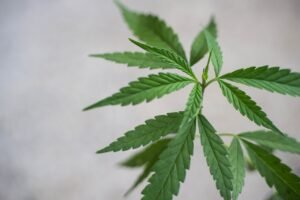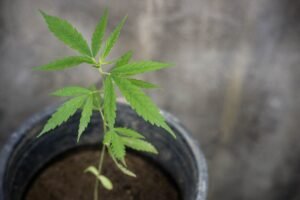Nurturing Cannabis Growth: A Guide to Weed Cultivation in the Vegetative Phase

Optimizing Cannabis Growth in the Vegetative Phase: Essential Tips and Techniques
WHAT IS THE VEGETATIVE PHASE?
Once cannabis seeds have germinated, they develop into seedlings and enter the vegetative phase before flowering. During this crucial stage, the seedlings undergo significant growth and prepare for future flowering.
In the first few weeks, seedlings will produce their first true leaves, alongside the initial cotyledons. As they continue to mature, an abundance of fan leaves will emerge, enabling efficient photosynthesis. This signifies the onset of the vegetative phase.
The duration of the vegetative phase varies depending on the genetics and cultivation goals. It typically spans from 3 to 16 weeks, or even longer. During this time, the plants experience rapid growth, often requiring transplantation into larger containers to accommodate their expanding root system. The main stem will elongate, and the internodal spacing will increase significantly. Indica strains tend to remain compact with extensive lateral branching, while sativa varieties grow taller with fewer side branches. For photoperiod varieties, the vegetative phase concludes when the light cycle shortens, triggering the transition to the flowering stage.
- Outdoors, This transition occurs during the shift from summer to autumn, marking a change in seasons.
- Indoors, The transition from the vegetative phase to the flowering stage is triggered by adjusting the lighting schedule. For photoperiod plants, the lighting cycle is shortened to 12 hours of light followed by 12 hours of darkness. This change prompts the plants to initiate flowering. On the other hand, autoflowering varieties enter the flowering stage based on their age rather than the light cycle.
 |
 |
 |
 |
| Growth phase (Week 1) | Growth phase (Week 2) | Growth phase (Week 3) | Growth phase (Week 4) |
 |
 |
 |
 |
| Growth phase (Week 5) | Growth phase (Week 6) | Growth phase (Week 7) | Growth phase (Week 8) |
Understanding the Significance of the Vegetative Phase
The vegetative phase plays a crucial role in the overall life cycle of a cannabis plant. It is during this phase that Growers favorite seeds must create the optimal environment for their plants to thrive and reach their maximum potential in terms of size and health. While larger plants often result in higher yields, size is not the sole determining factor.
Some growers prefer to maintain smaller plants while still achieving impressive yields, and this can be achieved through various training techniques applied during the vegetative stage, before the onset of flowering. Numerous essential physiological processes take place during this phase. The fan leaves actively convert light and CO₂ into energy, while the root system expands to provide stability and access to vital nutrients and water. To meet the demands of plants during this critical stage, growers must ensure they provide appropriate lighting, watering, and nutrient levels.
Additionally, cultivators must remain vigilant against pests and pathogens, taking preventive measures to protect their crops from potential damage or even complete loss. Ultimately, the vegetative period sets the foundation for successful flowering. The healthier and stronger the plants are during this phase, the better equipped they will be for the subsequent flowering stage, leading to a fruitful harvest.

Achieving Optimal Vegetative Growth: Essential Guidelines
Every cannabis cultivation is subject to the aforementioned factors. Achieving a harmonious equilibrium among these variables enables cultivators to witness extraordinary progress during the vegetative phase. While the fundamental needs of plants persist, growers must acknowledge the disparities between indoor and outdoor cultivation. These distinct environments pose diverse challenges to cultivators and their crops.
INDOOR
Cultivating plants indoors typically involves utilizing grow tents or dedicated grow rooms, which offer distinct advantages and disadvantages. Indoor growers enjoy a high level of control over the entire growth cycle’s environment. During the vegetative phase, they have the flexibility to provide 18-24 hours of light per day. Maximizing light exposure allows for enhanced photosynthesis, leading to vigorous vegetative growth. However, with increased control comes increased responsibilities.
Indoor growers must regularly monitor CO₂ levels, humidity, and temperature, ensuring they fall within specific parameters to optimize plant development. To maintain smooth operations, growers may need to invest in equipment such as fans, hygrometers, humidifiers/dehumidifiers, and extractor fans. Although automation through timers and sensors is possible, it may not be practical for novice or hobbyist cultivators.
OUTDOOR
Outdoor growers relinquish a significant degree of control over their plants during both the vegetative phase and the entire growing cycle. Nature’s elements assume command, which can prove advantageous in certain situations. One advantage is the absence of the need to provide artificial lighting, as natural sunlight suffices. Furthermore, regular rainfall and irrigation systems alleviate the necessity for frequent watering. Achieving optimal vegetative growth outdoors primarily involves bolstering plant defenses.
The outdoor environment teems with critters that readily feast on plants. Insects can infiltrate leaves and feast on roots, while birds and deer pose threats to leaves and stems. Additionally, humid conditions increase the risk of fungal infections. To combat these challenges, growers can introduce biological controls like predatory insects to eradicate pests and cultivate companion plants to deter them. Deploying nets and fences serves as an effective defense against larger animals, and foliar sprays can help prevent mold growth. Growers should also select areas in the garden with ample airflow, avoiding stagnant locations for their crops.
Nurturing Optimal Beginnings for Your Cannabis Seeds
As previously mentioned, the seedling stage precedes the vegetative phase and holds significant importance in the life of a cannabis plant, as it can shape its future. Similar to how robust vegetative growth sets the stage for an optimal flowering phase, a healthy seedling stage plays a crucial role throughout the entire growth cycle. Now, let’s explore essential factors to consider during this pivotal period.
-
GROWING MEDIUM
Growers have the flexibility to cultivate plants using different mediums, such as soil or hydroponics (water-based systems). The chosen growing medium serves as a nurturing environment for root development and, in the case of soil, provides organic matter and nutrients. It is advisable to introduce beneficial microorganisms, such as mycorrhizal fungi, into the soil to establish a symbiotic relationship with the plants.
These microorganisms aid in the decomposition of organic matter and facilitate nutrient absorption. In hydroponic setups, it is crucial to begin with high-quality, filtered water, as tap water often contains harmful substances like chlorine that can be detrimental to plant growth.
-
LIGHTING
Light stands as one of the utmost vital factors in cannabis cultivation, alongside water and CO₂, playing a pivotal role in the process of photosynthesis. To ensure robust and thriving growth, growers should begin with a quality set of lights. LED lights are highly recommended due to their economical operation and minimal heat emission. For indoor cultivation of photoperiod strains, it is essential to provide 18-24 hours of light per day during the vegetative phase, as greater light exposure accelerates growth.
Most cultivators maintain the vegetative stage for 4-8 weeks, after which a transition to 12 hours of daily light is necessary to trigger the flowering phase. On the other hand, autoflowering plants naturally transition to flowering without external manipulation. Supplying them with 18-24 hours of light throughout both the vegetative and flowering stages allows for their remarkable development..
-
NUTRITION
Cannabis plants possess distinct nutritional needs that vary between the vegetative and flowering phases. During the vegetative period, plants necessitate higher levels of nitrogen, essential for robust stem and leaf growth. Adequate potassium levels are also crucial for regulating stomata and energy production.
Magnesium plays a vital role in powering photosynthesis, while calcium ensures the health of cell walls. To simplify the process, cultivators can acquire vegetative nutrient formulas like Easy Grow Booster Tablets, which provide all the necessary nutrients throughout the entire vegetative stage. For hydroponic cultivation, it is advisable to purchase specific vegetative nutrients and apply them according to the provided instructions.
-
WATERING
Water, the essence of life itself. Cannabis plants rely on water for nutrient absorption in both soil and hydroponic cultivation. Through the process of transpiration, water ascends from the plant’s stem to its leaves, delivering vital nutrients to the required areas. Nevertheless, excessive water can have adverse effects.
Overwatering can deprive the roots of oxygen, potentially causing root rot. When watering plants in the vegetative phase, it is advisable to wait for the top approximately 3cm of soil to dry out before watering again. In hydroponic systems, plants receive the necessary water from their growing medium, eliminating the need for additional watering.
-
TEMPERATURE
Vegetative plants flourish within a temperature range of 20-30°C, which fortunately provides indoor and outdoor growers with considerable flexibility. These plants can withstand relatively high humidity levels, but it is crucial to avoid dropping below 40%. Monitoring temperature and humidity can be accomplished using a thermometer/hygrometer.
Indoor cultivators have the ability to adjust these conditions by employing heaters, air conditioning units, humidifiers, and dehumidifiers. In outdoor settings, growers can set up shelters to shield vegetating plants from excessive sunlight during intense heatwaves.
-
AIRFLOW
Ensuring proper airflow is essential for maintaining the well-being of vegetating plants. In a grow tent, the use of input and extractor fans is crucial to maintain fresh air circulation. These fans facilitate the intake of CO₂ while removing excess oxygen. Adequate airflow also plays a significant role in preventing the formation of mold. When cultivating outdoors within a polytunnel, it is advisable to position it in the direction of prevailing winds or consider installing fans to promote continuous air movement.
-
TRAINING
Training techniques empower growers to mold and manipulate plants according to their preferences. It enables them to expand the canopy, facilitating greater light penetration. Through training, growers can enhance yields while maintaining manageable plant heights. Approaches like low-stress training involve gently bending and securing stems and branches to alter the plant’s shape.
THE FIRST TWO WEEKS OF THE VEGETATIVE PHASE
During this period, plants exhibit rapid growth, necessitating continuous monitoring and adjustments by growers. When utilizing Easy Booster Tablets, feeding becomes a seamless task. However, it is crucial to closely monitor watering. Once again, it is recommended to wait until the top approximately 3cm of the soil has dried before watering again.
As plants experience accelerated growth, the position of lights may require alteration. To prevent light burn, the light source should be suspended around 30cm away from the top of the plant. If any leaf yellowing occurs, further distancing may be necessary.
Maintaining high humidity is essential during the initial two weeks of the vegetative stage. Increased moisture in the air enhances plant health, and this can be achieved by temporarily disabling fans indoors.
OTHER FACTORS TO CONSIDER DURING THE VEGETATIVE PHASE
Apart from the previously mentioned factors, there are numerous other essential considerations to keep in mind during the vegetative phase, regardless of the chosen cultivation method or environment.
-
SEXING
Determining the sex of cannabis plants holds significant importance to prevent male plants from pollinating the growing area. If the objective is to cultivate resinous flowers, it is crucial for growers to identify and remove male plants as early as possible. Once male pollen fertilizes female flowers, seed production is triggered, resulting in a decrease in resin production.
Sexing typically takes place around four weeks after germination when both male and female plants start producing pre-flowers, which are small tissue formations indicating their sex. Male pre-flowers have a more spherical shape, while female pre-flowers resemble teardrops. Growers can employ magnifying tools like a jeweler’s loupe to examine the nodes closely. If a male plant is identified, it should be promptly removed from the growing area. It can be kept separately for breeding purposes or disposed of accordingly.
-
SPACING
Providing adequate space for each plant is crucial. When plants become overcrowded, they compete for light and may hinder each other’s growth. Several factors come into play, including the strain’s genotype, which influences its size. However, training techniques can be employed to manage plant growth. Cultivators can strategically plan their grow space by determining the optimal number of plants per square meter.
- By employing the Sea of Green (SOG) technique, growers can typically accommodate 4-16 plants per square meter. This method entails planting numerous small-sized plants in close proximity, allowing them to form a uniform and horizontal canopy.
- As previously discussed, the low-stress training (LST) technique is employed to manage plant growth. Implementing LST allows growers to cultivate around four plants per square meter, optimizing the use of space effectively.
- Lastly, the Screen of Green (ScrOG) method can be utilized to maximize yield, although it is important to note that only a single plant can be accommodated per square meter.
-
TOPPING
Topping is a proven method used to manage the height of cannabis plants while maximizing their yield potential. By selectively pruning the top of the main stem, growers can stimulate lateral growth, leading to increased productivity. Topping can be performed when a plant has developed 3-5 nodes during the vegetative growth phase.
It is recommended to use sterilized scissors for this technique. By snipping off the tip of the main stem, the plant will branch out. This process can be repeated multiple times to encourage the development of more flowering sites. However, it’s important to note that each time a plant is topped, it requires a period of recovery, which inevitably extends the duration of the vegetative phase.
- Part 1: Germinating A Comprehensive Guide to Germinating Cannabis Seeds
- Part 3: Blooming phaseIn just a few more months of blooming, we’ll be prepared to retrieve our shears from the cupboard.
- Part 4: Last weeks of blooming After weeks of growing anticipation, the highly anticipated harvest moment is now within reach.
- Part 5: Harvest This comprehensive guide will walk you through every step of the harvest process, ensuring that you achieve a robust and potent stash.






